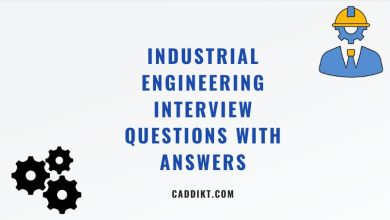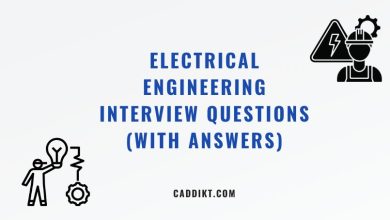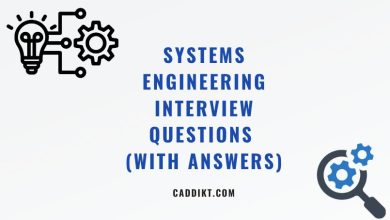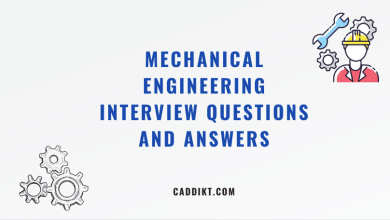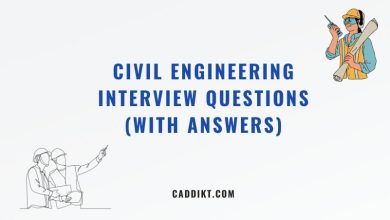In the ever-evolving world of technology, Electronic Engineering plays a pivotal role in shaping our modern society. Whether you’re a seasoned professional or a budding engineer, a successful interview is crucial to unlocking new opportunities in this field. To help you prepare, we have compiled a comprehensive list of 50 interview questions that cover the spectrum of electronic engineering knowledge. From the fundamentals to advanced concepts, these questions will test your understanding and expertise in areas like analog and digital circuits, components, power supplies, communication systems, and more. So, let’s dive into this treasure trove of knowledge and equip yourself with the confidence to ace your next electronic engineering interview.
From Basics to Advanced: 50 Must-Know Electronic Engineering Interview Questions
1. What is the fundamental difference between analog and digital circuits?
Analog circuits process continuous signals, while digital circuits process discrete signals represented by binary values.
2. Explain the concept of impedance in electronic circuits.
Impedance is the measure of opposition to the flow of alternating current (AC) in a circuit, combining resistance, inductance, and capacitance.
3. How does a diode work, and what are its applications?
A diode allows current to flow in one direction and blocks it in the opposite direction. It is used for rectification, switching, and signal demodulation.
4. What is the purpose of a transistor in electronic circuits?
A transistor amplifies and switches electronic signals. It is a fundamental building block of modern electronic devices.
5. Differentiate between CMOS and TTL logic families.
CMOS (Complementary Metal-Oxide-Semiconductor) and TTL (Transistor-Transistor Logic) are two popular logic families with different power consumption, noise immunity, and voltage levels.
6. What is the role of a capacitor in an electronic circuit?
A capacitor stores and releases electrical energy. It is used for filtering, energy storage, coupling, and timing applications.
7. Explain the working principle of a voltage regulator.
A voltage regulator maintains a constant output voltage despite variations in input voltage or load conditions. It regulates voltage using feedback control mechanisms.
8. What is the significance of the cut-off frequency in filters?
The cut-off frequency determines the range of frequencies that a filter allows to pass through or attenuates. It defines the filter’s performance and functionality.
9. How does an operational amplifier (op-amp) amplify signals?
An op-amp amplifies the voltage difference between its inputs. It has a high gain, input impedance, and common-mode rejection ratio, making it suitable for various applications.
10. What are the advantages and disadvantages of using transformers in power supplies?
Transformers provide voltage transformation, isolation, and impedance matching. However, they are bulky, have limited frequency response, and are not suitable for DC power.
11. Describe the working principle of a digital-to-analog converter (DAC).
A DAC converts digital signals into analog voltages or currents. It uses various techniques, such as binary-weighted, R-2R ladder, or delta-sigma modulation.
12. What are the key parameters to consider when selecting a microcontroller for a project?
Key parameters for microcontroller selection include performance, power consumption, memory size, input/output capabilities, communication interfaces, and development ecosystem.
13. Explain the concept of feedback in control systems.
Feedback is the process of taking a portion of the output signal and feeding it back to the input to modify or control the system’s behavior, improving stability and accuracy.
14. How does a phase-locked loop (PLL) function, and what are its applications?
A PLL locks the phase and frequency of an output signal to a reference signal. It is used for clock generation, frequency synthesis, modulation, and demodulation.
15. What is the role of a flip-flop in digital circuits?
A flip-flop is a sequential logic circuit that stores binary data. It is used for memory storage, synchronization, and building registers and counters.
16. How does a multiplexer differ from a demultiplexer?
A multiplexer combines multiple input signals into a single output, while a demultiplexer separates a single input signal into multiple outputs.
17. Describe the working principle of a field-effect transistor (FET).
A field-effect transistor controls the flow of current through the variation of an electric field. It uses the voltage applied to the gate to modulate the channel conductivity.
18. What are the advantages of using surface-mount technology (SMT) in circuit board assembly?
SMT offers smaller component size, higher component density, better thermal performance, and automated assembly, leading to reduced costs, improved reliability, and increased functionality.
19. How does an oscillator circuit generate stable clock signals?
An oscillator circuit utilizes positive feedback to sustain oscillations at a specific frequency. It typically uses a resonant circuit, such as an LC tank or a quartz crystal, to achieve stability.
20. Explain the concept of hysteresis in Schmitt trigger circuits.
Hysteresis is the phenomenon where the output of a circuit changes only when the input exceeds certain thresholds. In Schmitt trigger circuits, it provides noise immunity and helps in signal conditioning.
21. What is the purpose of a decoupling capacitor in power supply circuits?
A decoupling capacitor helps to filter out noise and stabilize the power supply voltage by providing a local reservoir of charge for immediate energy demands.
22. Describe the operation of a three-phase induction motor.
A three-phase induction motor uses rotating magnetic fields produced by three-phase AC currents to induce a current in the rotor. This interaction generates the torque required for motor operation.
23. How does pulse-width modulation (PWM) control the speed of a motor?
PWM controls the average voltage or current applied to a motor by rapidly switching it on and off. By adjusting the duty cycle of the PWM signal, the motor speed can be varied.
24. What are the key parameters to consider when designing a power amplifier?
Key parameters for power amplifier design include power output, efficiency, linearity, distortion, frequency response, stability, and thermal considerations.
25. Explain the concept of jitter in digital communication systems.
Jitter refers to the variation in the timing of a digital signal’s transitions. It can cause timing errors, data corruption, and signal integrity issues in high-speed communication systems.
26. What is the role of a rectifier circuit in converting AC to DC?
A rectifier circuit converts alternating current (AC) into direct current (DC) by utilizing diodes to allow current flow in only one direction.
27. Describe the working principle of a Hall effect sensor.
A Hall effect sensor detects the presence and strength of a magnetic field. It operates based on the Hall effect, where a voltage is generated perpendicular to the current flow in a conductor exposed to a magnetic field.
28. How does a voltage-controlled oscillator (VCO) function?
A voltage-controlled oscillator generates an output signal whose frequency is directly proportional to the voltage applied to its control input. It is commonly used in frequency synthesis, modulation, and demodulation applications.
29. What are the advantages and disadvantages of using surface-mount devices (SMDs) in circuit design?
Surface-mount devices offer smaller size, improved electrical performance, and easier automated assembly. However, they can be more challenging to repair or modify and require specialized equipment for soldering.
30. Explain the concept of bit error rate (BER) in digital communication systems.
Bit error rate is a measure of the number of erroneous bits received in a communication system compared to the total number of transmitted bits. It quantifies the system’s error performance and reliability.
31. What is the purpose of a clock signal in synchronous digital circuits?
A clock signal provides timing synchronization to ensure proper operation and sequencing of digital circuits. It enables synchronous operations and facilitates data transfer and processing.
32. Describe the working principle of a switched-mode power supply (SMPS).
A switched-mode power supply converts electrical energy efficiently from one voltage level to another using high-frequency switching. It typically consists of a rectifier, a high-frequency switch, an inductor, a transformer, and a rectifier.
33. How does a comparator differ from an operational amplifier?
A comparator compares two input voltages and produces a digital output based on the voltage comparison. An operational amplifier amplifies and processes analog signals using feedback to achieve specific functions.
34. What are the key parameters to consider when designing a printed circuit board (PCB)?
Key parameters for PCB design include board size, layer stackup, component placement, signal routing, power and ground plane design, thermal management, manufacturability, and electromagnetic compatibility (EMC).
35. Explain the concept of crosstalk in high-speed digital circuits.
Crosstalk is the undesired coupling of signals between adjacent traces or components on a PCB. It can cause signal interference, noise, and degradation of signal integrity, especially in high-speed digital circuits.
36. What is the role of a counter circuit in digital systems?
A counter circuit counts and keeps track of events or cycles. It is commonly used for timing, frequency division, and digital signal processing applications.
37. Describe the working principle of a varactor diode.
A varactor diode is a voltage-controlled device whose capacitance varies with the applied voltage. It is commonly used in tuning circuits, voltage-controlled oscillators, and frequency modulators.
38. How does a charge-coupled device (CCD) image sensor work?
A CCD image sensor converts light energy into electrical signals by capturing and transferring charge packets through an array of pixels. It is used in digital cameras, scanners, and image processing applications.
39. What are the advantages and disadvantages of using integrated circuits (ICs) in electronic designs?
Integrated circuits offer miniaturization, improved performance, increased reliability, and reduced power consumption. However, they may limit flexibility, pose challenges for troubleshooting, and require complex fabrication processes.
40. Explain the concept of thermal runaway in semiconductor devices.
Thermal runaway refers to the self-reinforcing increase in temperature of a semiconductor device due to positive feedback between temperature and current. It can lead to device failure and is mitigated through thermal management techniques.
41. What is the purpose of a voltage divider circuit?
A voltage divider circuit divides a voltage into smaller fractions using resistors. It is commonly used to create reference voltages, biasing circuits, and level shifting in electronic circuits.
42. Describe the operation of a buck-boost converter in power supply applications.
A buck-boost converter is a type of DC-DC converter that can step up or step down the input voltage to provide a regulated output voltage. It is used in battery-powered systems and portable electronics.
43. How does a phase-locked loop (PLL) achieve frequency synthesis?
A phase-locked loop compares the phase and frequency of a reference signal with a controlled oscillator to generate an output signal with a desired frequency. It uses feedback and control mechanisms to lock the output frequency to the reference.
44. What are the key considerations for electromagnetic compatibility (EMC) in circuit design?
Key considerations for EMC include proper grounding, signal isolation, shielding, filtering, and minimizing electromagnetic interference to ensure the reliable operation of electronic devices in the presence of electromagnetic radiation.
45. Explain the concept of jitter in phase-locked loops (PLLs).
Jitter in PLLs refers to the variation in the output signal’s timing caused by noise, phase fluctuations, or frequency deviations. It can affect the performance of communication systems, especially in high-speed data transmission.
46. What is the role of a buffer amplifier in electronic circuits?
A buffer amplifier isolates and provides impedance matching between circuits with different input and output impedance. It helps prevent loading effects and ensures signal integrity during signal transmission.
47. Describe the operation of a charge pump circuit.
A charge pump circuit generates a higher voltage or converts a DC voltage to a different level using a series of switches and capacitors. It operates based on the transfer of charge between capacitors.
48. How does a sigma-delta (ΣΔ) ADC achieve high-resolution conversion?
A sigma-delta ADC achieves high-resolution conversion by oversampling the input signal, applying noise shaping, and utilizing a digital filter. It achieves high accuracy by trading off bandwidth for increased resolution.
49. What are the advantages and disadvantages of using field-programmable gate arrays (FPGAs)?
FPGAs offer flexibility, reprogrammability, and parallel processing capabilities. However, they can be more expensive, consume more power, and have longer development cycles compared to application-specific integrated circuits (ASICs).
50. Explain the concept of power factor correction.
Power factor correction is the technique of adjusting the input current waveform to minimize reactive power and improve the power factor in AC circuits. It helps optimize power distribution, reduce energy losses, and comply with utility regulations.
Conclusion
Congratulations! You have now explored a diverse range of 50 interview questions in the field of Electronic Engineering. We hope this compilation has provided valuable insights into the essential concepts, principles, and applications within the field. Remember, interview success often stems from a combination of technical knowledge, problem-solving skills, and effective communication. As you continue to pursue your career in electronic engineering, keep learning, stay curious, and embrace new challenges. With dedication and a solid foundation in the fundamentals, you’ll be well-equipped to navigate the ever-evolving landscape of this exciting field. Best of luck on your journey to a rewarding and fulfilling career in Electronic Engineering!


